The 5-Stage Sustainability Journey
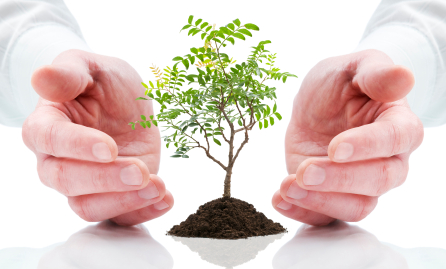
As companies progress toward being sustainable enterprises, we can position them on a five-stage sustainability continuum. They evolve from an unsustainable model of business in Stages 1, 2 and 3, to a sustainable business framework in Stages 4 or 5. Executive mindsets also evolve from thinking of “green,” “environmental,” and “sustainable” initiatives as expensive and bureaucratic threats in the early stages, to recognizing them as catalysts for strategic growth in the later stages.
We will use the 3-nested-dependencies model of a sustainable society, described in my July 20, 2010 blog, to describe the characteristics of companies in the five key stages on their sustainability journeys.
Stage 1: Pre-ComplianceIn this stage, the company cuts corners, and tries to not get caught if it breaks the law or uses exploitative practices that cheat the system. It ignores any notions of sustainability and flouts environmental, health, and safety regulations. This stage is the norm in corrupt jurisdictions. In developed countries, it is a risky stage and not a wise one to linger in. Most smart companies move quickly to Stage 2 in order to avoid fines, prosecution, and public embarrassment for illegal acts.
Stage 2: Compliance
Here, the business manages its liabilities by obeying all labor, environmental, health, and safety regulations. It reactively does what it’s legally bound to do, and it follows these laws well. Companies install pollution abatement equipment and provide a safer, healthier, more respectful workplace for employees. However, environmental and philanthropic social actions are treated as costs; pollution abatement projects are end-of-pipe retrofits; and corporate social responsibility is given lip service—at best.
A Stage 1 company’s actions are illegal and unsustainable. A Stage 2 company’s actions are legal but they’re still unsustainable. Companies in both stages use a linear take-make-waste model of commerce that violates the fundamental principles of a sustainable enterprise as shown in the adjacent slide. They treat Nature as a dump site for the waste created when extracting the natural resources required for their products. They treat Nature as a dump site for the waste created from their manufacturing processes. Nature’s dump site fills with the end-of-life disposal of their goods when consumers are finished with them.
With this model, we risk drowning in our own waste. Over-consumption by the haves causes social unrest and violence among the have-nots. Companies happily externalize many of their ecological and social impacts that arise from this model of business. However, society is starting to demand that they be more accountable for their collateral social and environmental damage.
Stage 3: Beyond compliance
A company voluntarily moves to Stage 3 when it realizes that it can save money with proactive, operational eco-efficiencies. These incremental savings can be reaped in four ways: 1. saving energy and reducing its associated carbon footprint; 2. saving water; 3. saving materials in its products and packaging; and 4. saving waste-handling costs. A company increases its community investment, thereby enhancing its reputation and maximizing shareholder value. However, sustainability initiatives are still marginalized within specialized departments. They are tacked on as green housekeeping, rather than being institutionalized in the company’s governance systems. This is still an unsustainable business, just less so. Stage 3 companies prolong the time it will take to drown in our own waste, rather than stopping their fundamentally unsustainable practices.
Stage 4: Integrated StrategyBy Stage 4, the firm has transformed its business model into a sustainable borrow-use-return design. It re-brands itself as a company committed to sustainability. It injects sustainability principles into its values and company DNA. And, it coordinates sustainability approaches with key business strategies. A Stage 4 company captures added value from breakthrough sustainability initiatives that benefit all stakeholders. Instead of seeing “green” costs and risks, it sees investments and opportunities. Stage 4 companies make cleaner products, apply eco-effectiveness and life-cycle stewardship, and enjoy competitive advantages from their sustainability initiatives.
Stage 5: Passion and Purpose
Driven by a passionate, values-based commitment to improve the well-being of the company, society, and the environment, a Stage 5 company helps build a better world because it is the right thing to do. Company values mirror founder / CEO values. Some founder-owned and founder-led companies start and end in this stage without ever entering the other four stages, such as Seventh Generation led by Jeffrey Hollander; Patagonia led by Yvon Chouinard; and my publisher, New Society Publishers, led by Chris and Judith Plant. Publicly-traded companies may evolve to Stage 5 once the legitimacy of social and environmental metrics is embraced in the business community.
Stages 4 and 5: What’s different?
About 90% of the behaviours of Stage 4 and Stage 5 companies look the same. They both adopt the cyclical, sustainable borrow-use-return business model. They both deploy business strategies that respect the environment, the community, and the ongoing business health of the firm. It’s the motivation that differs. Stage 4 companies “do the right things” so that they are successful businesses. Stage 5 companies are successful businesses so that they can continue to “do the right things.” The dotted line between Stage 4 and Stage 5 in the above slide denotes this motivational difference.
Does it matter whether a company is in Stage 4 or Stage 5? We’d all like companies to do the right things for the right reasons, but it really doesn’t matter for results. Our priority is to quickly achieve a critical mass of companies that behave more sustainably, so that we can reach the tipping point of momentum of sustainable firms for a sustainable planet. Whatever works to get us there will do. We’ll work on motivations some other time.
In next week’s blog, we’ll examine why the take-make-waste model used by Stage 1, 2 and 3 companies is fundamentally unsustainable. With that background, in the week following, we’ll show why the borrow-use-return business model used by companies in Stage 4 or 5 is preferable and sustainable.
‘Til then…
Bob
As usual, the above slides are part of my Master Slide Set.
Please feel free to add your comments and questions using the Comment link below.
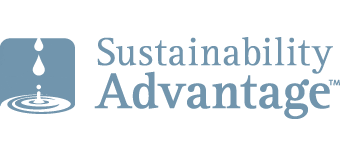
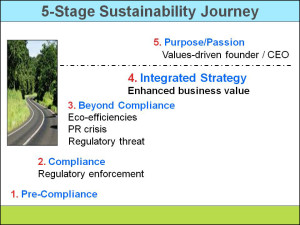
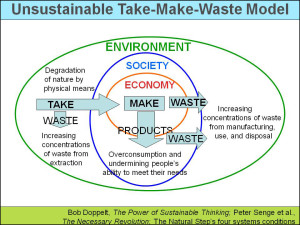
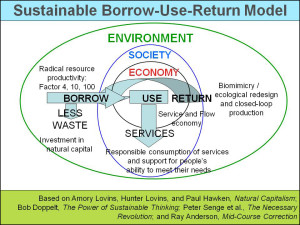



Comments are closed.